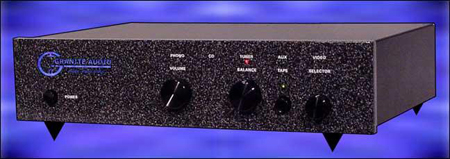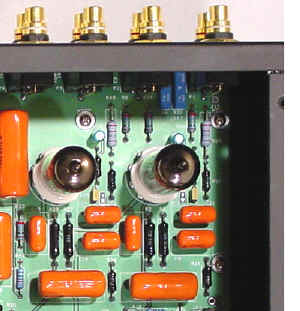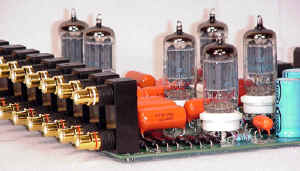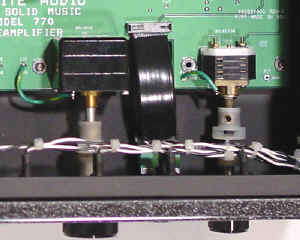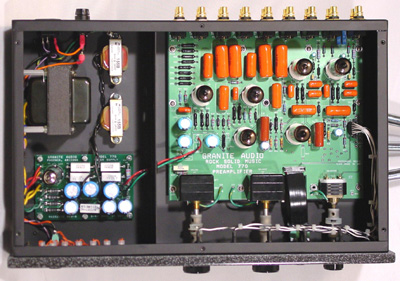|
You are reading the older HTML site
Positive Feedback ISSUE 6 granite audio 770FP preamplifier as reviewed by Mike Malter
|
||
|
|
The Granite Audio Preamp delivers the magic of music. Listening with this preamp is one of those hair raising on the back of my neck while I'm tapping my toes kind of experiences. A vinyl recording of Orphee Aus Enfers is playing as I write this, and I am tapping my toes to the beat, laughing with joy at what I am hearing. I feel at one with the emotion of the music. If that is not enough, this preamp makes CDs sound good. For the first time, the difference between Redbook and SACD can be clearly heard in my listening room. When I listen to SACDs, I can hear what all the fuss is about, and I definitely like what I hear. While vinyl is still my comfort food, my investment in CDs, especially in SACDs, does not have to go to waste. No matter the medium—CD, SACD, or vinyl—complex musical passages are presented coherently, on a grand scale. Many instruments play together, yet the sound of each instrument is apparent. Another of my reasons for loving the Granite preamp is that the phono stage is so good. This is really a phono stage with a preamp wrapped around it. For example, the dual chokes in the power supply that filter out 60-cycle hum are there for the benefit of the phono stage. Very particular attention was given to filtering out noise and producing a velvety-black, quiet background. This quiet is reflected in the signal-to-noise curve, which has only a 2-db difference between the straight and A-weighted curves. Finally, the phono stage has Vishay input trimmers that are user adjustable for cartridge loading from 0 to 100,000 ohms, which should handle just about every cartridge out there (see below).
Let's look at the unit more closely. First, the tube-rectified (6x4) power supply is in a compartment separated by a heavy-gauge steel barrier. This barrier greatly reduces the huge amount of noise generated, and it is welded to the rest of the case to minimize vibration. All wires are twisted around each other to take advantage of common-mode rejection of 60-cycle hum. The power supply also uses a dual choke to filter out 60 and 120 cycle hum from the filaments of the tubes (see below) .
The other tubes in the preamp are six 12AX7s (see above). The preamp's designer, Don Hoglund, says that these tubes like to be hot, and when you put your hand on the top, you know he's right. This goes double for the single power tube, which gets quite toasty. The tubes are housed in ceramic sockets that have silver plated, self-wiping pin receptacles. This prevents the socket from spreading each time you change tubes.
On the front, you get four input selections plus phono. Volume and balance controls are Alps Black Beauties (see above). Don Hoglund says that switch quality is a large part of sound quality, so all switches are of military specification, and are either solid silver or gold-plated copper—no brass or nickel are used. The switches are rated for over 25,000 on/off cycles, and should last 70 to 100 years (divide 25,000 by 365 days—it will take at least 68 years before degradation of the switches even starts). All switches are hermetically sealed. Around the back (see below), you get RCA connectors with gold plating over silver plating over copper plating, with no brass. The connectors are very nicely spaced, with room for thick connectors. There are six pairs of inputs and a line-level tape out pair that can double as a home theater bypass. There are also two pairs of main outs. These provide a lot of flexibility for bi-amping. The two pairs of jacks are physically isolated from each other, not bridged, and one pair is 3db higher in output (this can be changed at the factory). The significance of this is that the performance of the preamp does not change if you have more than one amp. The isolation keeps your amps from interacting with each other, so one amp can present different demands without interacting or sucking current destined for the other.
With a piece of gear this outstanding, I was intrigued by what went into it to make it sound so good. What I mean by so good is that this preamp by my way of thinking is so incredibly musical. It is also extremely quiet, a virtue for its built-in phono stage as well as in general for allowing fine and subtle detail to emerge. Furthermore it handles very complex musical passages such that fine instrumental detail is apparent while at the same time maintaining the broader musical picture. Its tonality to my ear, or shall I say tastes, are correct. I tried to find weaknesses to write about. And I am embarrassed to say I couldn't find any, at least from a musical perspective. The only weakness I found here was the lack of a remote, and that was not so much of a weakness as it was a design choice. I also found out that the success of this preamp is as much originality of design as careful attention to detail. Preamp design is a battle of inches. The values that are dealt with are miniscule, and these miniscule values have mammoth effects on the music we hear. To begin to give you an idea of the detail that went into this unit, when you remove the top plate, the metal edges that it sits on are covered with thin strips of velvet to eliminate any possible vibrations from the screws on the top cover from coming loose and producing microphonic vibrations.
Furthermore, the main circuit board has four layers (see above), to eliminate the need for parallel traces. Don says that these parallel traces act as antennas and transmitters, and will produce crosstalk between left and right channels as well as generating interference between one stage and the next. Even a quarter of an inch of exposed wire will pick up noise. The four-layer board eliminates exposed wires and traces, and there's also a solid layer of copper shield between each of the layers, to create a shield for the entire circuit. Don knew that he was going to have to do something to make a place for himself in the industry, and that the approach he took was as important as the components he used: "I don't want my preamp to sound good," he said. "I don't want it to have any sound at all. You are buying my preamp to listen to Dianna Krall. You want to hear her sing, you don't want to hear my preamp sing." Break-in is always a dicey proposition. While lots of people do not believe in it, I always do it before I judge any piece of equipment. In my experience, there is often a wide degree of difference in a component's performance before and after break-in. I first plugged my CD player with the Granite Audio Phono Burn-in RIAA Test CD into the Granite phono stage for 400 hours, taking notes all the way. Despite the fact that the unit was new, there was very little change. It sounded superb right out of the box, and stayed superb throughout. There was some opening up of inner detail, but that was it. After break-in, I had the best time listening to music that I have ever had. I would like to share some of the highlights of my experience, to reveal both the strengths and weaknesses of the preamp and, in the case of vinyl, its phono stage. For my vinyl references, I first chose Also Sprach Zarathustra, performed by the Chicago Symphony Orchestra and George Solti. This is a very complex piece with enormous range, and because of this, much can get lost in reproduction. That was not the case here. It seems that the more complex a piece of music, the more the Granite Audio phono stage likes it. The opening buzz representing the nothingness of the Universe was clear, not at all mushy. When God spoke, even during the crescendo of the Grand Voice, each instrument sounded separate and clear. This rendition has a lot of bass, and it was always tight, never mushy or bloated, and never emphasized at the expense of higher-pitched instruments or the gestalt of the piece. I never heard any kind of congestion. The sound was natural, open, and spacious, never harsh or glary. Next up, Kind of Blue. What's not to like? I heard sound that was wide and spacious, with small details very easy to hear. The bass was clean and tight, the highs crystal clear. The music was liquid and smooth, with a strong, solid presence. Finally, I choose a 99-cent refugee from the local Goodwill, the Muse release of The Great Classical Music of the World series published by Dong Hwa Publishing of South Korea. I grabbed a huge stack of these, and like them for their dog's breakfast approach to classical music. It was these 99-cent beauties that really let me know what kind of preamp and phono stage the Granite Audio truly is. The Muse series took me all over the map. Two things were important to me. The first was that I did not like the composition of some of the music, but loved it as organic music. I could not do this before. If I did not immediately relate emotionally to a piece of music, it was out—aloha to a steel guitar, baby!—but with this preamp, the music came through. I was listening to music, not sound, and could appreciate a piece for its musical value even though its entertainment value might not be very high. The second thing was the pure elation of listening to these recordings. The biggest hit was on the ninth record of the series. The first cut, "Orphee Aus Enfers," left me laughing with joy. It was early on a Sunday morning, and I was trying to take notes, but this can-can music sent me into orbit. I have listened to this piece on different phono stage and preamp combinations, but no reproduction struck me as it did through the Granite Audio preamp. One final note about the phono stage—it is exceedingly quiet. On to SACD. Wondering how the preamp would capture the breadth and depth of Wagner's musical palette, I chose highlights from the Ring of the Nibelungen as rendered by the Cleveland Orchestra directed by George Szell. I also chose this recording because it was re-mastered from original analog tape and not a true original DSD recording. My intent was not only to see if I could ride the heavens on Wagner's Valkyries, but to get the sense of early SACD releases in general. Both happened. The SACD thing is totally happening with this preamp. I had to tie my hands down to my chair to keep from cranking up the volume during Die Walkure. I became a modern-day Ulysses, bound to my mast, drunk with the madness of the sirens, flinging oaths at the heavens. It wasn't until the delicateness of the fourth cut, "Siegfried," that I calmed down and re-entered civilization. This preamp will do that to you. (This is just an aside, but important nonetheless: The little bells in "Siegfried" were just so delicate and pure. They were not mushy, smudgy, high-pitched sounds that my brain says were bells. They were, well, bells.) Next I wanted to get the full SACD monty, so to speak, so I selected a release that was an original DSD recording, The Film Music of Jerry Goldsmith. The Granite Audio preamp brought out the spectacular nature of this SACD—wide, spacious sounding, with wonderful detail, lots of energy, and pinpoint imaging. For me, a highlight of this disc came from the events of 9/11. I have to admit that I was rattled and pretty scared for a few days. During that time, I would put this SACD on and listen to "Air Force One." It always calmed me down, and steeled my nerve so to speak. Now, after those fearful days had passed and I listened to it again, I found the cut majestic and heartwarming in new ways. Finally, I just had to hear how the Granite Audio handled Japanese SACD's, my favorite being a jazz recording by Venus records of the Richie Beirach Trio, What is this Thing Called Love. The third cut, "Night and Day," highlights the bass and has a kickin' drum solo. The bass was just right, and I could feel George Mraz pulling the strings. When Billy Hart worked the drums, I could feel wood on animal skin, not just hear it. The most surprising thing about this preamp was the fact that I really enjoyed listening to CDs, which had not happened in a very long time. In fact, I had given up on CDs, thinking it was going to be a vinyl existence for me. Instead, that hashy, harsh sound was gone, and what was previously unlistenable became a joy. The Granite preamp gave new life to my CD collection. The first CD I played was Paul Horn's Tibet, which I selected because of the wide-ranging, eclectic nature of its sounds. Horn recorded background sounds and music in Tibet, then interspersed them with his flute to create a wonderful and interesting release. He also did some interesting things with the soundstage, and I wanted to hear how the preamp handled it. With the Granite Audio preamp, the soundstage is a natural part of the music. I was very surprised when listening to the first cut, "The Journey Begins." The soundstage was huge, larger than I had ever experienced with my system. It extended to my listening position—I turned my head several times because it sounded like someone was standing right next to me trying to say something. It was everywhere. The preamp handled this CD wonderfully, bringing through its exotic, deep horns, drums, and noisemakers of every kind. I felt transfixed and mystified by subtle musical sounds, which were not overpowered by more deep, earthy ones. It was an exotic banquet for the ears and soul. The last CD had to be piano. The piano is hard to reproduce. It is also my favorite instrument. I love piano solos, and in my mind the master soloist is Arthur Rubinstein, who I think is at his best when playing Chopin. Chopin has his own challenges. Early in his career, he was not well received because his music was so quiet and delicate. There is a story about Count Moritz Lichnowsky, a friend of Beethoven's who remarked, after Chopin's first concert in Vienna, that he needed a louder piano. Add to that what Rubinstein said in his documentary about playing Chopin. With some of his pieces, the music was so delicate that he had to put his foot on the middle pedal of the piano to further dampen his playing. After he said that, he looked at the camera and requested that they cut this statement because it was his secret about playing Chopin. I was particularly interested to hear how the preamp would handle Rubinstein playing Chopin, and it had the thing—the softness, subtlety, and delicacy of Chopin tugged at my heartstrings. Notes softly and sweetly emerged from a totally quiet, black background. I don't know why this piece of equipment makes my setup so musical. Don Hoglund says he focused on the basics of good engineering and attempted to kill electronic noise, minimize vibration, and use quality parts everywhere. Well, doesn't everybody? I don't really have a killer CD player or turntable—they are okay, but no great shakes. I have used much, much better source equipment without these results. Personal bias is also a factor to consider, as I prefer the neutral (what I call neutral, anyway) to the soft and sweet or the bold and brassy.If I were to compare this preamp to the greats I have owned or heard I would say it has the clarity and detail of the Audio Research Reference One but is more musical and that it has the musicality of the Audio Note M3 but with more presence. So I think that the answer is going to be one of life's mysteries. At any rate, if your priority is music, do yourself a favor and get your hands on one of these units. That special something might come through for you. It definitely did for me. Mike Malter
|
|
|
|
770FP preamplifier Granite
Audio |

